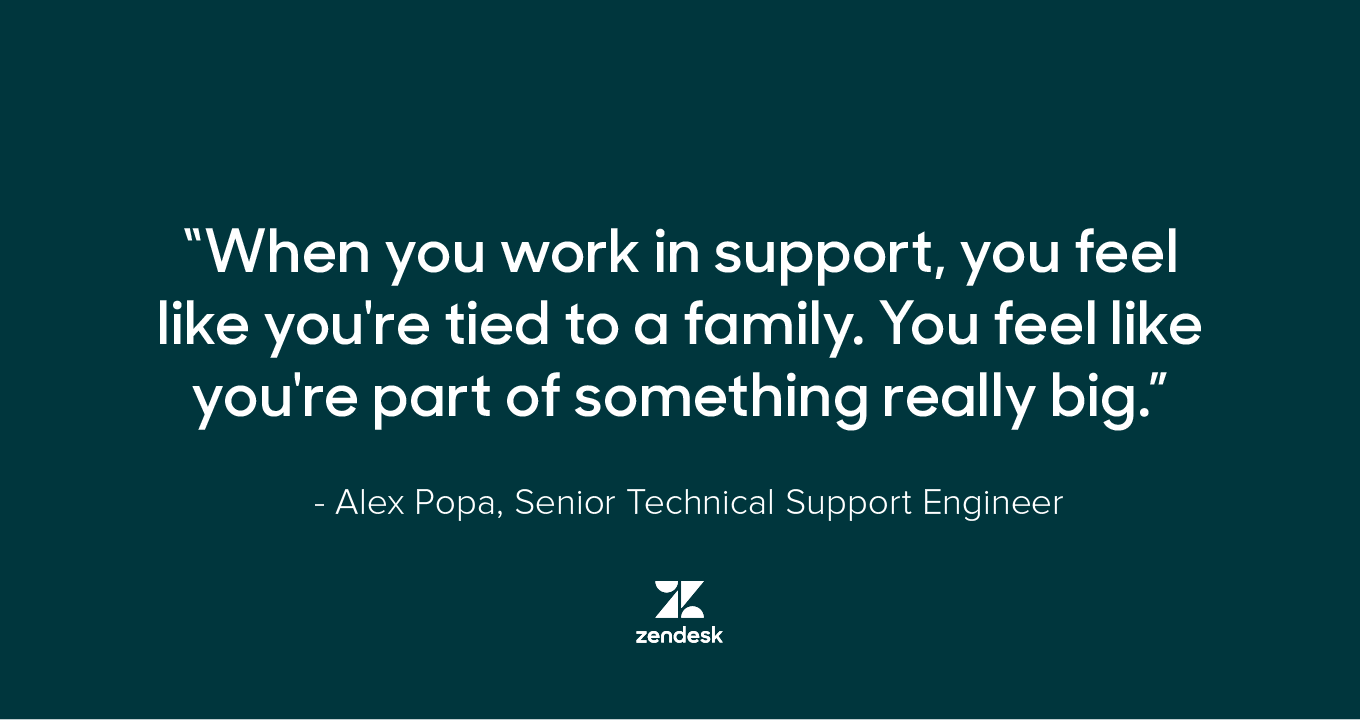Article • 4 min read
Communication is key to great tech support
By Suzanne Barnecut
Last updated August 8, 2017
When Alex Popa was hired to be Zendesk’s first technical support advocate in the Copenhagen office more than two years ago, he was still living in Romania. He attended school in a small city in Denmark more than a decade earlier and felt drawn to the country’s capital city.
“It was funny. I visited Copenhagen back in 2013 and something just clicked. This is why, in 2015, when I saw the opening in Copenhagen, I was like, ‘This was the sign,’” he said.
It was that sign that led Alex to a job that’s a perfect fit for him: his current role as a senior technical support engineer.

Alex has a background in technical support, but it was his experience as a history and French teacher that fine-tuned his knack for communicating. Through teaching, he learned to be observant. His advice for good communication: “Stop, listen, then communicate” because that’s when you can ask, “…are they really getting the message that you want to send or should you move in a different direction?”
Back then he was communicating with students, parents, and fellow teachers, but in his current role handling complex technical issues, he moves between communicating with customers and others at Zendesk, including advocates and the product managers and development teams who build the software that advocates support.
Learning never stops, even for top tier support
Alex is known for his upbeat personality and for reaching out to those around Zendesk. His connection to co-workers means he’s constantly learning about product features so he can deliver better customer support.
“I really love the fact that we learn everything day by day. It’s not like history where that thing happened. It might not happen again,” he said. “Things are happening every day so fast. You need to keep the pace, and you need to learn everything. I think this is what’s really amazing about our jobs. You constantly keep on learning new things.”
Alex loves the challenge of learning about customers’ unique workflows, discovering what they are trying to accomplish, and applying his expertise to find a solution. For Alex, the best interactions are when he’s able to help a customer during his first contact with them. Getting customers answers quickly is the reward for committing to learning as much as he can.

Internal communication aids customer relationships
Connecting with colleagues also means building relationships among a group of people united in a common purpose: to help customers. That creates a rapport that feels like family, which is how Alex describes both the global Advocacy team at Zendesk and the Copenhagen office.
“When you work in support, you feel like you’re tied to a family. You feel like you’re part of something really big,” he said.
Friendly impromptu conversations and Friday happy hours in Copenhagen mean the team gets to not only catch up on what’s happening at work but also swap stories and share the latest in their personal lives. Gatherings like these can help support teams who want to improve their communication. Another way someone can help build team camaraderie is to remember why they got into customer service.
“One needs to actually show that they really care about others, because, in the end, this is what we do and this is why we’re here,” he said. “We care about others and we want to help. Otherwise, we would probably have other jobs.”
Hear from more Zendesk advocates:
Abel Martin, on building great internal partnerships
Arthur Mori, on what everyone should know about Tier 1 support
Benjamin Towne, on mentoring and offering constructive criticism
Rodney Lewis, on setting up an internal shadowing program
Sarah Kay, on her move from advocate to data analyst
Ramona Lopez, on rolling out an advocate recognition program
Aurash Pourmand, on practicing customer empathy
Anna Lee Ledesma, on the skill every great chat agent needs to have
Mark Fado, on providing dedicated 1:1 client support
Justin Helley, on advocacy training and development
Guillaume Deleeuw, on problem-solving in Tier 2 technical support
DeShawn Witter, on providing support in your community
The Tier 3 team, on bringing a hive mentality to work
Peachy Garcia, with best practices for handling chats
Jen Neuls, on the art of business analysis